Leadership Competencies: Analysis of Skills and Development Strategies
VerifiedAdded on 2022/10/15
|8
|1808
|21
Report
AI Summary
This report delves into the multifaceted realm of leadership and management, focusing on the critical competencies required for success in today's dynamic environment. It begins by defining global leadership and its significance, highlighting the skills and behaviors that contribute to effective performance. The report then explores the competencies needed in various contexts, including the public sector and multiracial communities, emphasizing the importance of training and development. It examines the impact of mega-trends like digital transformation and data-driven insights on leadership, and discusses the distinction between management and leadership, emphasizing the visionary and change-oriented nature of effective leaders. The report also touches upon cultural influences on leadership styles, such as paternalistic leadership in Turkish contexts, and the role of culture and diversity in fostering successful workplaces. Finally, it underscores the importance of leaders adapting to shared leadership environments and building strong mentoring relationships to navigate the complexities of the modern business landscape. The report uses multiple references from academic journals and books to support its arguments.

Leadership and Management
Paraphrase This Document
Need a fresh take? Get an instant paraphrase of this document with our AI Paraphraser
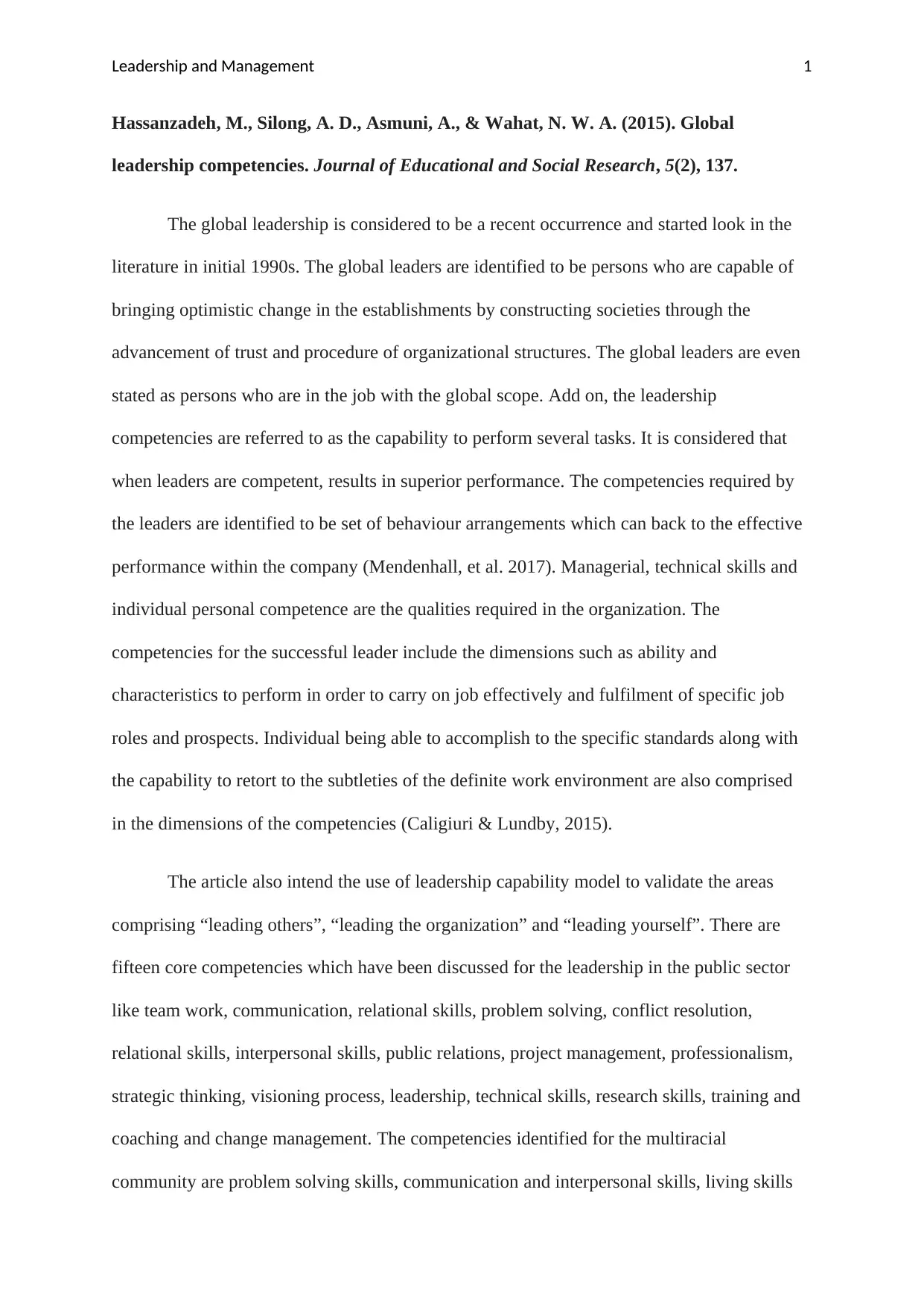
Leadership and Management 1
Hassanzadeh, M., Silong, A. D., Asmuni, A., & Wahat, N. W. A. (2015). Global
leadership competencies. Journal of Educational and Social Research, 5(2), 137.
The global leadership is considered to be a recent occurrence and started look in the
literature in initial 1990s. The global leaders are identified to be persons who are capable of
bringing optimistic change in the establishments by constructing societies through the
advancement of trust and procedure of organizational structures. The global leaders are even
stated as persons who are in the job with the global scope. Add on, the leadership
competencies are referred to as the capability to perform several tasks. It is considered that
when leaders are competent, results in superior performance. The competencies required by
the leaders are identified to be set of behaviour arrangements which can back to the effective
performance within the company (Mendenhall, et al. 2017). Managerial, technical skills and
individual personal competence are the qualities required in the organization. The
competencies for the successful leader include the dimensions such as ability and
characteristics to perform in order to carry on job effectively and fulfilment of specific job
roles and prospects. Individual being able to accomplish to the specific standards along with
the capability to retort to the subtleties of the definite work environment are also comprised
in the dimensions of the competencies (Caligiuri & Lundby, 2015).
The article also intend the use of leadership capability model to validate the areas
comprising “leading others”, “leading the organization” and “leading yourself”. There are
fifteen core competencies which have been discussed for the leadership in the public sector
like team work, communication, relational skills, problem solving, conflict resolution,
relational skills, interpersonal skills, public relations, project management, professionalism,
strategic thinking, visioning process, leadership, technical skills, research skills, training and
coaching and change management. The competencies identified for the multiracial
community are problem solving skills, communication and interpersonal skills, living skills
Hassanzadeh, M., Silong, A. D., Asmuni, A., & Wahat, N. W. A. (2015). Global
leadership competencies. Journal of Educational and Social Research, 5(2), 137.
The global leadership is considered to be a recent occurrence and started look in the
literature in initial 1990s. The global leaders are identified to be persons who are capable of
bringing optimistic change in the establishments by constructing societies through the
advancement of trust and procedure of organizational structures. The global leaders are even
stated as persons who are in the job with the global scope. Add on, the leadership
competencies are referred to as the capability to perform several tasks. It is considered that
when leaders are competent, results in superior performance. The competencies required by
the leaders are identified to be set of behaviour arrangements which can back to the effective
performance within the company (Mendenhall, et al. 2017). Managerial, technical skills and
individual personal competence are the qualities required in the organization. The
competencies for the successful leader include the dimensions such as ability and
characteristics to perform in order to carry on job effectively and fulfilment of specific job
roles and prospects. Individual being able to accomplish to the specific standards along with
the capability to retort to the subtleties of the definite work environment are also comprised
in the dimensions of the competencies (Caligiuri & Lundby, 2015).
The article also intend the use of leadership capability model to validate the areas
comprising “leading others”, “leading the organization” and “leading yourself”. There are
fifteen core competencies which have been discussed for the leadership in the public sector
like team work, communication, relational skills, problem solving, conflict resolution,
relational skills, interpersonal skills, public relations, project management, professionalism,
strategic thinking, visioning process, leadership, technical skills, research skills, training and
coaching and change management. The competencies identified for the multiracial
community are problem solving skills, communication and interpersonal skills, living skills
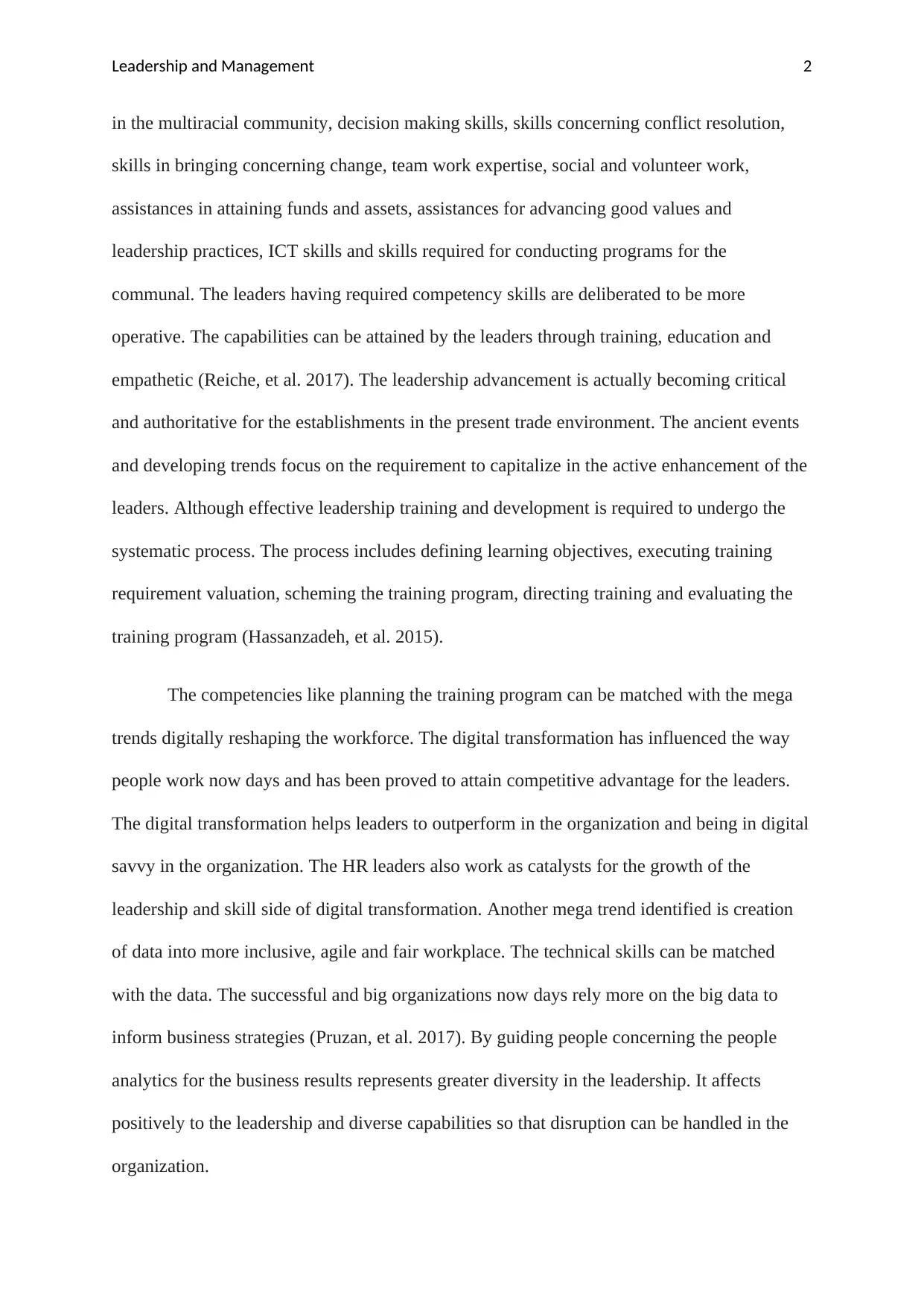
Leadership and Management 2
in the multiracial community, decision making skills, skills concerning conflict resolution,
skills in bringing concerning change, team work expertise, social and volunteer work,
assistances in attaining funds and assets, assistances for advancing good values and
leadership practices, ICT skills and skills required for conducting programs for the
communal. The leaders having required competency skills are deliberated to be more
operative. The capabilities can be attained by the leaders through training, education and
empathetic (Reiche, et al. 2017). The leadership advancement is actually becoming critical
and authoritative for the establishments in the present trade environment. The ancient events
and developing trends focus on the requirement to capitalize in the active enhancement of the
leaders. Although effective leadership training and development is required to undergo the
systematic process. The process includes defining learning objectives, executing training
requirement valuation, scheming the training program, directing training and evaluating the
training program (Hassanzadeh, et al. 2015).
The competencies like planning the training program can be matched with the mega
trends digitally reshaping the workforce. The digital transformation has influenced the way
people work now days and has been proved to attain competitive advantage for the leaders.
The digital transformation helps leaders to outperform in the organization and being in digital
savvy in the organization. The HR leaders also work as catalysts for the growth of the
leadership and skill side of digital transformation. Another mega trend identified is creation
of data into more inclusive, agile and fair workplace. The technical skills can be matched
with the data. The successful and big organizations now days rely more on the big data to
inform business strategies (Pruzan, et al. 2017). By guiding people concerning the people
analytics for the business results represents greater diversity in the leadership. It affects
positively to the leadership and diverse capabilities so that disruption can be handled in the
organization.
in the multiracial community, decision making skills, skills concerning conflict resolution,
skills in bringing concerning change, team work expertise, social and volunteer work,
assistances in attaining funds and assets, assistances for advancing good values and
leadership practices, ICT skills and skills required for conducting programs for the
communal. The leaders having required competency skills are deliberated to be more
operative. The capabilities can be attained by the leaders through training, education and
empathetic (Reiche, et al. 2017). The leadership advancement is actually becoming critical
and authoritative for the establishments in the present trade environment. The ancient events
and developing trends focus on the requirement to capitalize in the active enhancement of the
leaders. Although effective leadership training and development is required to undergo the
systematic process. The process includes defining learning objectives, executing training
requirement valuation, scheming the training program, directing training and evaluating the
training program (Hassanzadeh, et al. 2015).
The competencies like planning the training program can be matched with the mega
trends digitally reshaping the workforce. The digital transformation has influenced the way
people work now days and has been proved to attain competitive advantage for the leaders.
The digital transformation helps leaders to outperform in the organization and being in digital
savvy in the organization. The HR leaders also work as catalysts for the growth of the
leadership and skill side of digital transformation. Another mega trend identified is creation
of data into more inclusive, agile and fair workplace. The technical skills can be matched
with the data. The successful and big organizations now days rely more on the big data to
inform business strategies (Pruzan, et al. 2017). By guiding people concerning the people
analytics for the business results represents greater diversity in the leadership. It affects
positively to the leadership and diverse capabilities so that disruption can be handled in the
organization.
⊘ This is a preview!⊘
Do you want full access?
Subscribe today to unlock all pages.

Trusted by 1+ million students worldwide
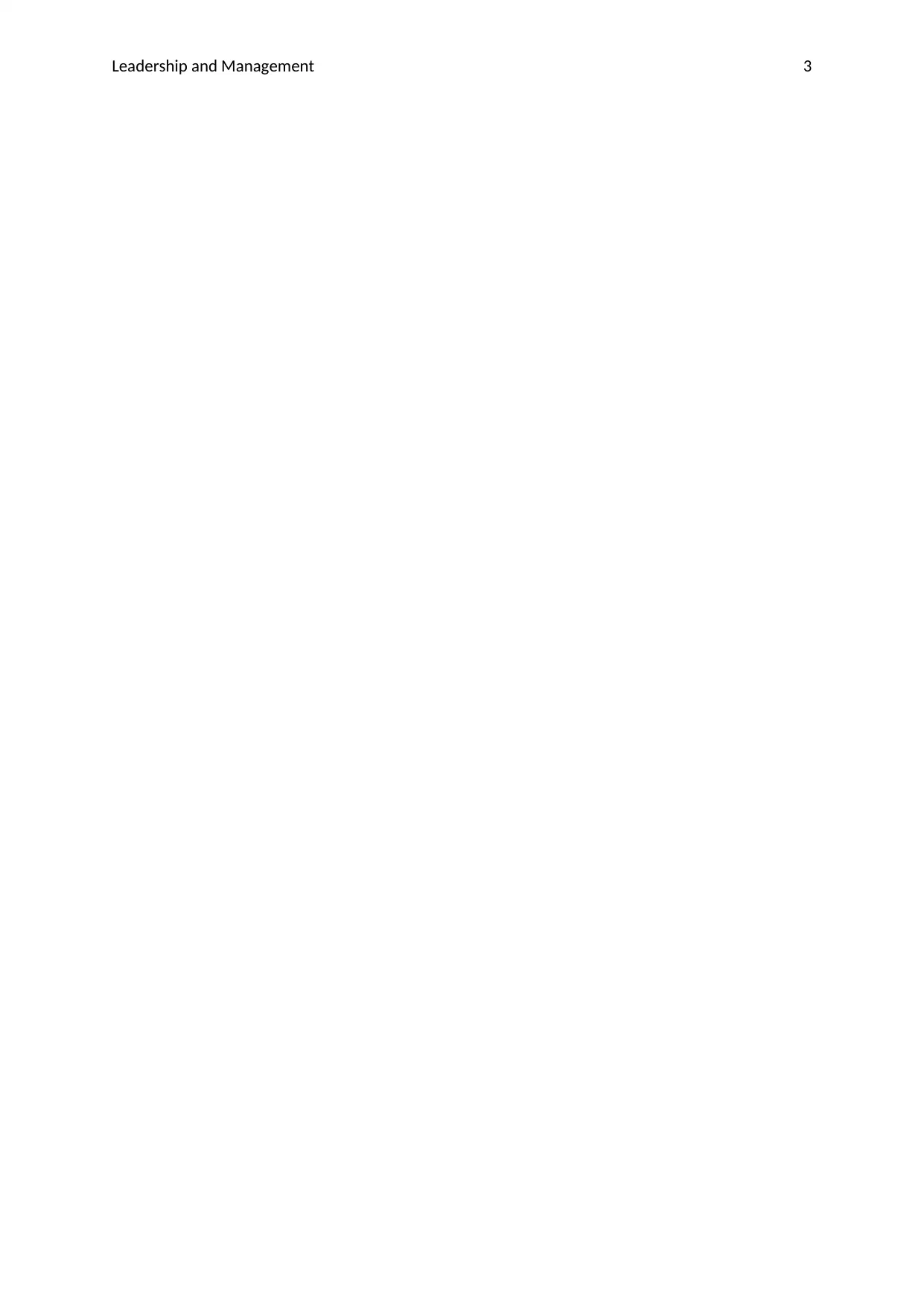
Leadership and Management 3
Paraphrase This Document
Need a fresh take? Get an instant paraphrase of this document with our AI Paraphraser
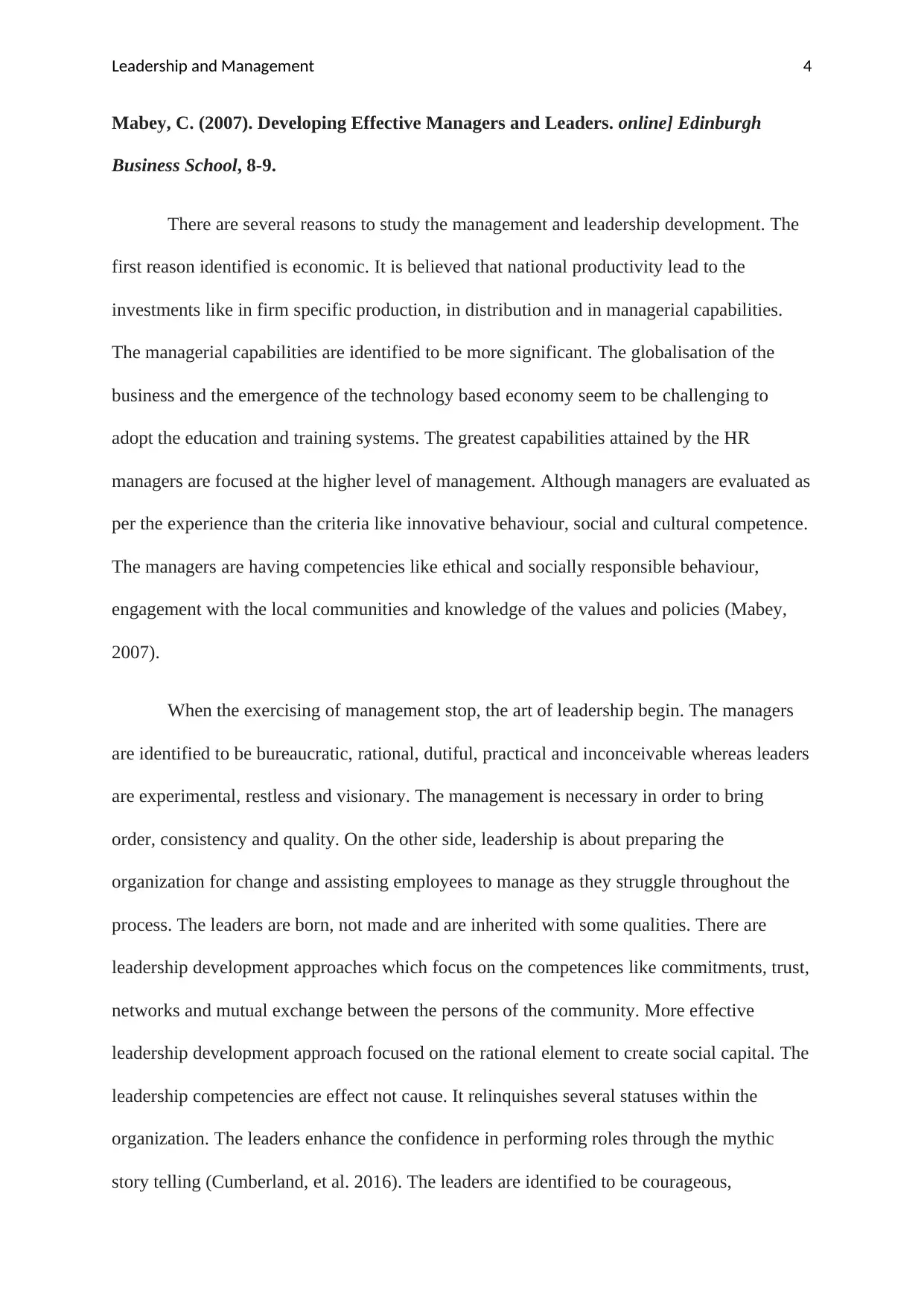
Leadership and Management 4
Mabey, C. (2007). Developing Effective Managers and Leaders. online] Edinburgh
Business School, 8-9.
There are several reasons to study the management and leadership development. The
first reason identified is economic. It is believed that national productivity lead to the
investments like in firm specific production, in distribution and in managerial capabilities.
The managerial capabilities are identified to be more significant. The globalisation of the
business and the emergence of the technology based economy seem to be challenging to
adopt the education and training systems. The greatest capabilities attained by the HR
managers are focused at the higher level of management. Although managers are evaluated as
per the experience than the criteria like innovative behaviour, social and cultural competence.
The managers are having competencies like ethical and socially responsible behaviour,
engagement with the local communities and knowledge of the values and policies (Mabey,
2007).
When the exercising of management stop, the art of leadership begin. The managers
are identified to be bureaucratic, rational, dutiful, practical and inconceivable whereas leaders
are experimental, restless and visionary. The management is necessary in order to bring
order, consistency and quality. On the other side, leadership is about preparing the
organization for change and assisting employees to manage as they struggle throughout the
process. The leaders are born, not made and are inherited with some qualities. There are
leadership development approaches which focus on the competences like commitments, trust,
networks and mutual exchange between the persons of the community. More effective
leadership development approach focused on the rational element to create social capital. The
leadership competencies are effect not cause. It relinquishes several statuses within the
organization. The leaders enhance the confidence in performing roles through the mythic
story telling (Cumberland, et al. 2016). The leaders are identified to be courageous,
Mabey, C. (2007). Developing Effective Managers and Leaders. online] Edinburgh
Business School, 8-9.
There are several reasons to study the management and leadership development. The
first reason identified is economic. It is believed that national productivity lead to the
investments like in firm specific production, in distribution and in managerial capabilities.
The managerial capabilities are identified to be more significant. The globalisation of the
business and the emergence of the technology based economy seem to be challenging to
adopt the education and training systems. The greatest capabilities attained by the HR
managers are focused at the higher level of management. Although managers are evaluated as
per the experience than the criteria like innovative behaviour, social and cultural competence.
The managers are having competencies like ethical and socially responsible behaviour,
engagement with the local communities and knowledge of the values and policies (Mabey,
2007).
When the exercising of management stop, the art of leadership begin. The managers
are identified to be bureaucratic, rational, dutiful, practical and inconceivable whereas leaders
are experimental, restless and visionary. The management is necessary in order to bring
order, consistency and quality. On the other side, leadership is about preparing the
organization for change and assisting employees to manage as they struggle throughout the
process. The leaders are born, not made and are inherited with some qualities. There are
leadership development approaches which focus on the competences like commitments, trust,
networks and mutual exchange between the persons of the community. More effective
leadership development approach focused on the rational element to create social capital. The
leadership competencies are effect not cause. It relinquishes several statuses within the
organization. The leaders enhance the confidence in performing roles through the mythic
story telling (Cumberland, et al. 2016). The leaders are identified to be courageous,
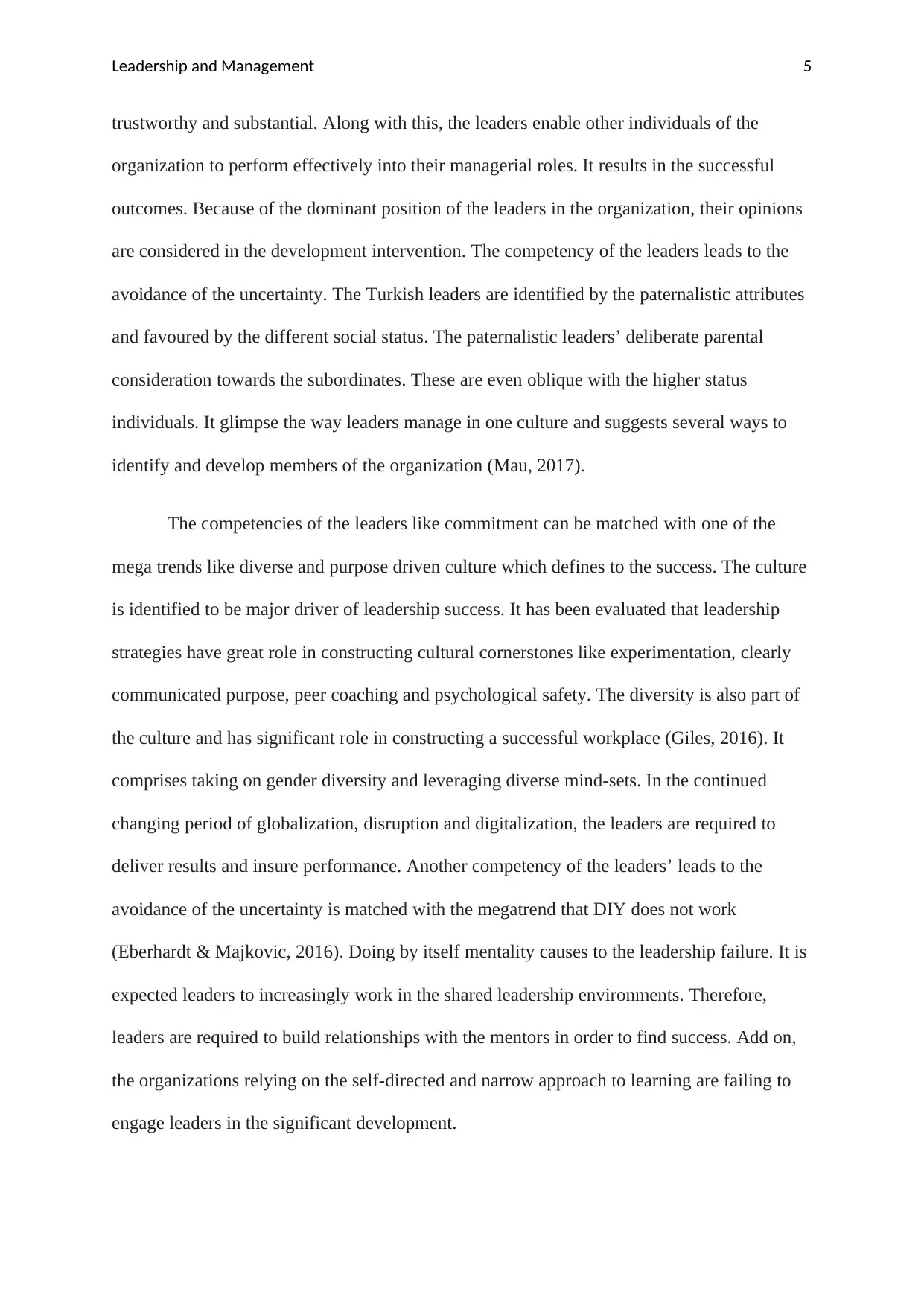
Leadership and Management 5
trustworthy and substantial. Along with this, the leaders enable other individuals of the
organization to perform effectively into their managerial roles. It results in the successful
outcomes. Because of the dominant position of the leaders in the organization, their opinions
are considered in the development intervention. The competency of the leaders leads to the
avoidance of the uncertainty. The Turkish leaders are identified by the paternalistic attributes
and favoured by the different social status. The paternalistic leaders’ deliberate parental
consideration towards the subordinates. These are even oblique with the higher status
individuals. It glimpse the way leaders manage in one culture and suggests several ways to
identify and develop members of the organization (Mau, 2017).
The competencies of the leaders like commitment can be matched with one of the
mega trends like diverse and purpose driven culture which defines to the success. The culture
is identified to be major driver of leadership success. It has been evaluated that leadership
strategies have great role in constructing cultural cornerstones like experimentation, clearly
communicated purpose, peer coaching and psychological safety. The diversity is also part of
the culture and has significant role in constructing a successful workplace (Giles, 2016). It
comprises taking on gender diversity and leveraging diverse mind-sets. In the continued
changing period of globalization, disruption and digitalization, the leaders are required to
deliver results and insure performance. Another competency of the leaders’ leads to the
avoidance of the uncertainty is matched with the megatrend that DIY does not work
(Eberhardt & Majkovic, 2016). Doing by itself mentality causes to the leadership failure. It is
expected leaders to increasingly work in the shared leadership environments. Therefore,
leaders are required to build relationships with the mentors in order to find success. Add on,
the organizations relying on the self-directed and narrow approach to learning are failing to
engage leaders in the significant development.
trustworthy and substantial. Along with this, the leaders enable other individuals of the
organization to perform effectively into their managerial roles. It results in the successful
outcomes. Because of the dominant position of the leaders in the organization, their opinions
are considered in the development intervention. The competency of the leaders leads to the
avoidance of the uncertainty. The Turkish leaders are identified by the paternalistic attributes
and favoured by the different social status. The paternalistic leaders’ deliberate parental
consideration towards the subordinates. These are even oblique with the higher status
individuals. It glimpse the way leaders manage in one culture and suggests several ways to
identify and develop members of the organization (Mau, 2017).
The competencies of the leaders like commitment can be matched with one of the
mega trends like diverse and purpose driven culture which defines to the success. The culture
is identified to be major driver of leadership success. It has been evaluated that leadership
strategies have great role in constructing cultural cornerstones like experimentation, clearly
communicated purpose, peer coaching and psychological safety. The diversity is also part of
the culture and has significant role in constructing a successful workplace (Giles, 2016). It
comprises taking on gender diversity and leveraging diverse mind-sets. In the continued
changing period of globalization, disruption and digitalization, the leaders are required to
deliver results and insure performance. Another competency of the leaders’ leads to the
avoidance of the uncertainty is matched with the megatrend that DIY does not work
(Eberhardt & Majkovic, 2016). Doing by itself mentality causes to the leadership failure. It is
expected leaders to increasingly work in the shared leadership environments. Therefore,
leaders are required to build relationships with the mentors in order to find success. Add on,
the organizations relying on the self-directed and narrow approach to learning are failing to
engage leaders in the significant development.
⊘ This is a preview!⊘
Do you want full access?
Subscribe today to unlock all pages.

Trusted by 1+ million students worldwide
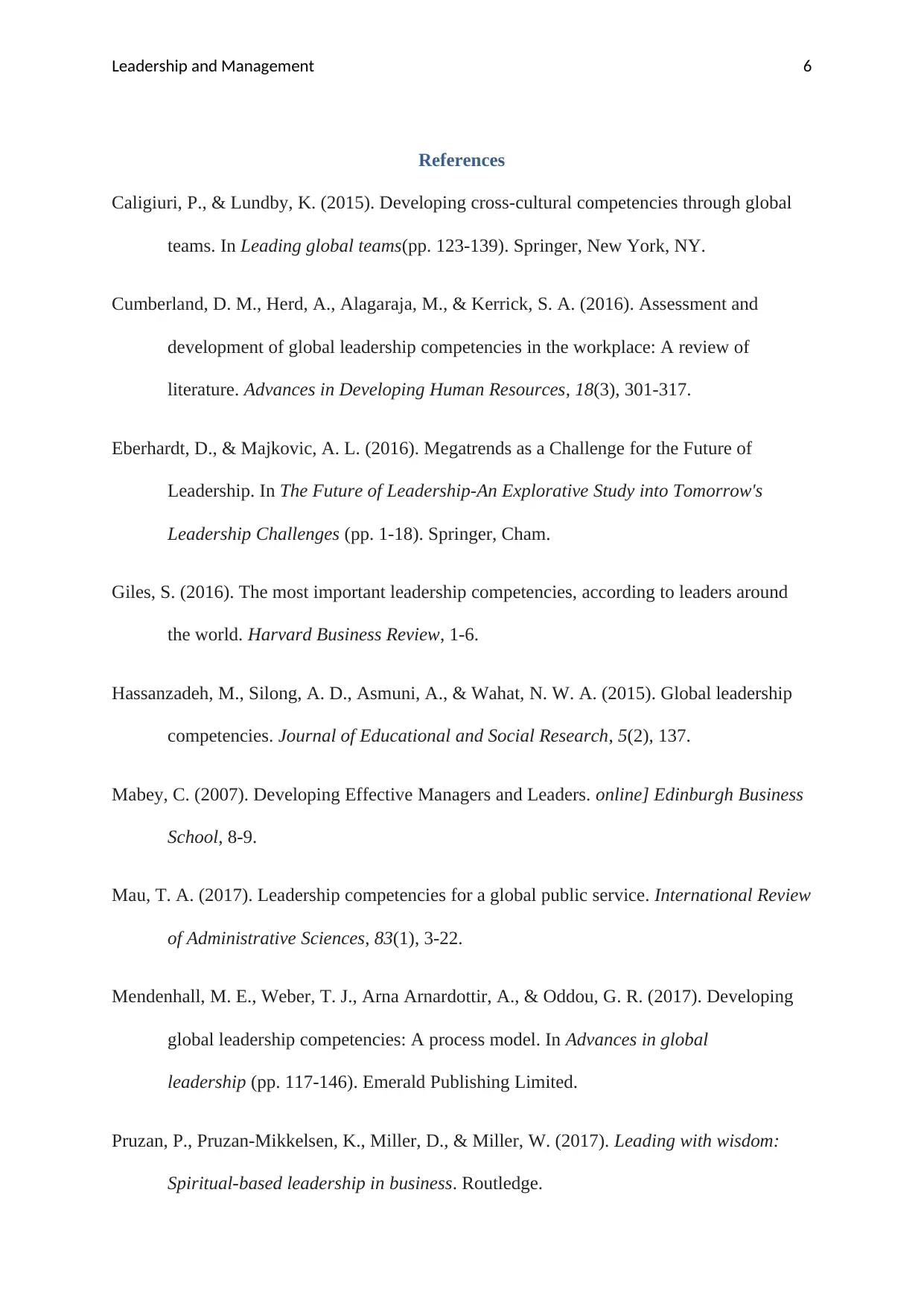
Leadership and Management 6
References
Caligiuri, P., & Lundby, K. (2015). Developing cross-cultural competencies through global
teams. In Leading global teams(pp. 123-139). Springer, New York, NY.
Cumberland, D. M., Herd, A., Alagaraja, M., & Kerrick, S. A. (2016). Assessment and
development of global leadership competencies in the workplace: A review of
literature. Advances in Developing Human Resources, 18(3), 301-317.
Eberhardt, D., & Majkovic, A. L. (2016). Megatrends as a Challenge for the Future of
Leadership. In The Future of Leadership-An Explorative Study into Tomorrow's
Leadership Challenges (pp. 1-18). Springer, Cham.
Giles, S. (2016). The most important leadership competencies, according to leaders around
the world. Harvard Business Review, 1-6.
Hassanzadeh, M., Silong, A. D., Asmuni, A., & Wahat, N. W. A. (2015). Global leadership
competencies. Journal of Educational and Social Research, 5(2), 137.
Mabey, C. (2007). Developing Effective Managers and Leaders. online] Edinburgh Business
School, 8-9.
Mau, T. A. (2017). Leadership competencies for a global public service. International Review
of Administrative Sciences, 83(1), 3-22.
Mendenhall, M. E., Weber, T. J., Arna Arnardottir, A., & Oddou, G. R. (2017). Developing
global leadership competencies: A process model. In Advances in global
leadership (pp. 117-146). Emerald Publishing Limited.
Pruzan, P., Pruzan-Mikkelsen, K., Miller, D., & Miller, W. (2017). Leading with wisdom:
Spiritual-based leadership in business. Routledge.
References
Caligiuri, P., & Lundby, K. (2015). Developing cross-cultural competencies through global
teams. In Leading global teams(pp. 123-139). Springer, New York, NY.
Cumberland, D. M., Herd, A., Alagaraja, M., & Kerrick, S. A. (2016). Assessment and
development of global leadership competencies in the workplace: A review of
literature. Advances in Developing Human Resources, 18(3), 301-317.
Eberhardt, D., & Majkovic, A. L. (2016). Megatrends as a Challenge for the Future of
Leadership. In The Future of Leadership-An Explorative Study into Tomorrow's
Leadership Challenges (pp. 1-18). Springer, Cham.
Giles, S. (2016). The most important leadership competencies, according to leaders around
the world. Harvard Business Review, 1-6.
Hassanzadeh, M., Silong, A. D., Asmuni, A., & Wahat, N. W. A. (2015). Global leadership
competencies. Journal of Educational and Social Research, 5(2), 137.
Mabey, C. (2007). Developing Effective Managers and Leaders. online] Edinburgh Business
School, 8-9.
Mau, T. A. (2017). Leadership competencies for a global public service. International Review
of Administrative Sciences, 83(1), 3-22.
Mendenhall, M. E., Weber, T. J., Arna Arnardottir, A., & Oddou, G. R. (2017). Developing
global leadership competencies: A process model. In Advances in global
leadership (pp. 117-146). Emerald Publishing Limited.
Pruzan, P., Pruzan-Mikkelsen, K., Miller, D., & Miller, W. (2017). Leading with wisdom:
Spiritual-based leadership in business. Routledge.
Paraphrase This Document
Need a fresh take? Get an instant paraphrase of this document with our AI Paraphraser
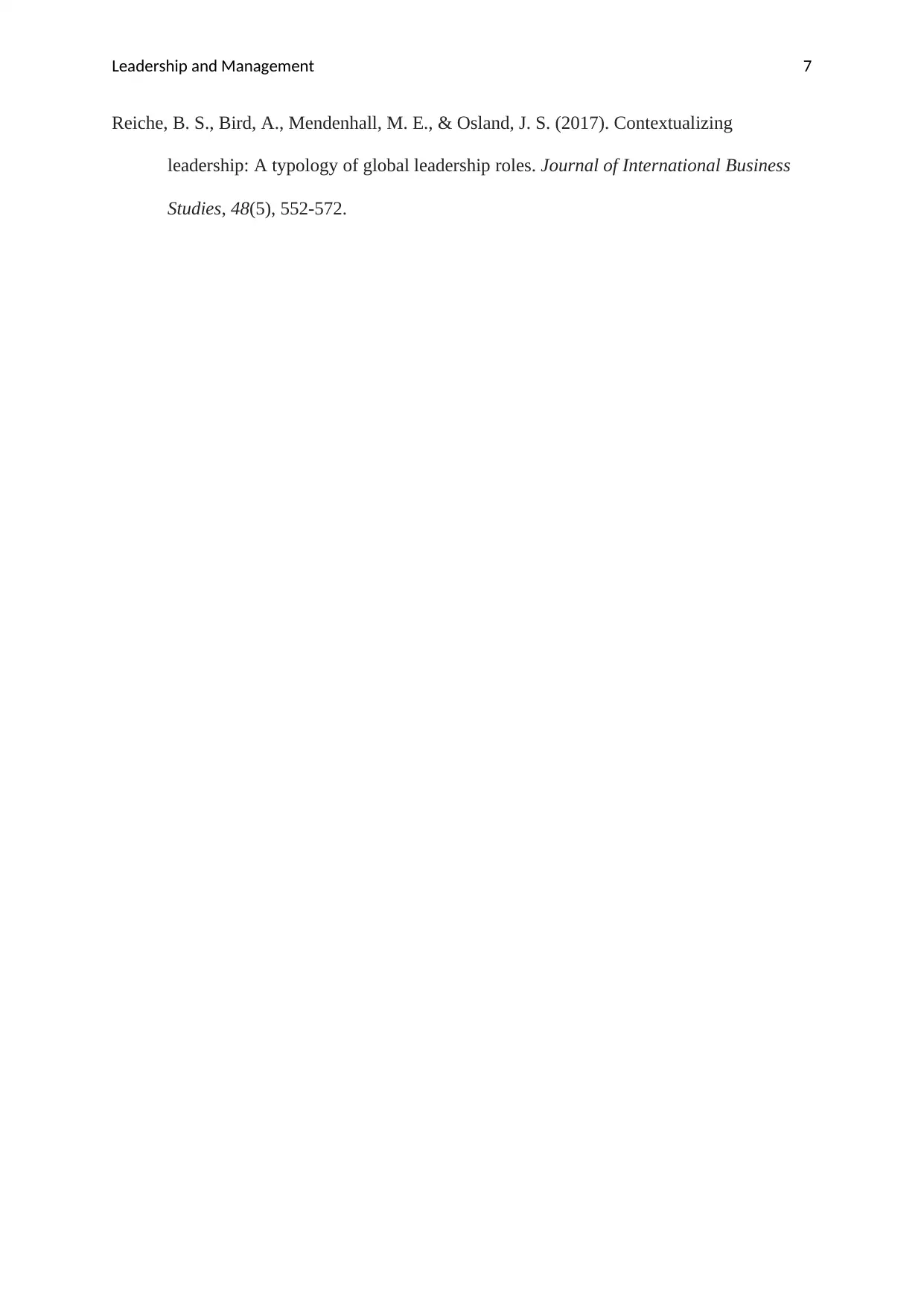
Leadership and Management 7
Reiche, B. S., Bird, A., Mendenhall, M. E., & Osland, J. S. (2017). Contextualizing
leadership: A typology of global leadership roles. Journal of International Business
Studies, 48(5), 552-572.
Reiche, B. S., Bird, A., Mendenhall, M. E., & Osland, J. S. (2017). Contextualizing
leadership: A typology of global leadership roles. Journal of International Business
Studies, 48(5), 552-572.
1 out of 8
Related Documents
Your All-in-One AI-Powered Toolkit for Academic Success.
+13062052269
info@desklib.com
Available 24*7 on WhatsApp / Email
![[object Object]](/_next/static/media/star-bottom.7253800d.svg)
Unlock your academic potential
Copyright © 2020–2025 A2Z Services. All Rights Reserved. Developed and managed by ZUCOL.




